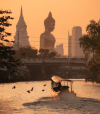
A cultural guide to Bangkok
By Alex Gorton
September 2023
Tuk-tuk your way around glitzy skyscrapers and ancient temples, taking in art, history, flavorful street fare, and buzzing nightlife along the way
Your essential guide to the best things to see and do in Bangkok. Find more travel inspiration for more amazing cities here.
Thailand’s colorful capital is a vast, balmy, magnificent city of contrasts, from ancient temples and wooden houses on stilts to glitzy rooftop bars and stylish skyscraper hotels. Beginning life as a small village in the 15th century and established as Thailand’s capital in 1782, Bangkok today has a busy, bustling feel. The winding Chao Phraya River cuts through the sprawl, with longtail boats and water taxis providing easy access to important sites such as the Grand Palace and its sacred temples.
Get a taste of traditional Thailand by visiting the vast Chatuchak Weekend Market or head to infamous backpacker hub Khao San Road (somewhat gentrified these days) to unwind. From old to new, Bangkok is a 24/7 city where there’s always somewhere to go and something to eat (and eat and eat—the food is so good): It’s the gateway to Thailand that you won’t want to leave.
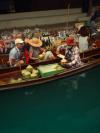
Floating markets line the city’s river and canals

Bangkok’s glitzy skyline contrasts with its ancient temples
Art & architecture
The Bangkok skyline is a jumble of the old juxtaposed with the new. Huge skyscrapers such as King Power MahaNakhon and Magnolias Waterfront Residences, as well as quirky buildings such as Elephant Tower and the Robot Building, showcase the city’s modern side.
Lower to the ground, the Jim Thompson House, a teak house museum filled with treasure collected by the American silk merchant, demonstrates the traditional. The Museum of Contemporary Art (MOCA) is home to more than 800 works, while Bangkok Art and Culture Centre consists of nine floors, each housing a different exhibition. Less touristy, Warehouse 30 is a once-abandoned 1940s complex that’s now home to exhibitions, film screenings, design studios, independent boutiques and cafés.
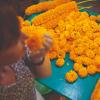
Bright, lively and fragrant—the city’s markets are a feast for the senses
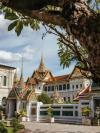
Golden thrones and emerald Buddhas await at the Grand Palace
Expert tips
The essentials
The local currency is the Thai baht. Suvarnabhumi Airport (BKK) is the main airport in Bangkok, while Don Mueang Airport (DMK) services international flights within Asia. From Suvarnabhumi, the Airport Rail Link (ARL) train is the quickest way to travel to central Bangkok (26 mins); you can buy tickets online in advance.
When dining out, a 10% service charge is usually added to your bill. Leave a small cash tip elsewhere, like shophouse restaurants and street stalls.
Bangkok is hottest in April, while rainy season is between May and early October. The weather is milder and pleasant in high season from November to March. If visiting temples, wear long but light trousers and tops that cover the knees and shoulders. Songkran (Thai New Year) takes place in April. Expect high heat and vibrant street festivities, including ritual water cleansing and communal water play.
Getting around
To avoid Bangkok’s traffic, zip around by Skytrain (BTS) or Metro (MRT), which run from 6 a.m. until midnight. Buy a day pass at a station for unlimited rides. Hop in a cash-only tuk-tuk for short trips or download a local app to book taxis. Allow lots of time for traveling across the city. Although rules are changing post-pandemic, it is still good etiquette to wear facemasks on public transit as most locals do.
LGBTQ+
Bangkok is considered one of the most LGBTQ+ friendly cities in Asia. Silom is noted for its LGBTQ+ nightlife, with Silom Soi 2 and Soi 4 packed with bars. Bangkok Pride takes place in early June, with a parade and festival. Many hotels typically host parties and events.
Accessibility
Every metro station in Bangkok has elevators and wheelchair access. Skytrain offers step-free access at some stations. Footpaths across the city are often narrow, uneven and busy. Those with mobility issues will find sightseeing easier around Wat Arun and Wat Pho. The Grand Palace is suitable for wheelchairs and the visually and hearing impaired.
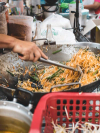
Be sure to sample the city's street food specialties
Food & drink
Dining is an incredibly social activity in Bangkok, with everything from super-cheap street eats to five-star restaurants on the menu. Iconic street-food destination Raan Jay Fai is so good it’s won a Michelin star (the crab omelet is out of this world), although there are countless options all over the city open from late afternoon into the early hours. Yaowarat Road is something of a hotspot with Guay Jub Ouan Pochana, T&K Seafood and Sweettime all very popular. Take a private food tour to experience it all.
Meanwhile, chicer venues include Issaya Siamese Club, set in a 100-year-old Thai villa, and Supanniga Eating Room. And it would be a crime not to enjoy a drink with a view at one of the many rooftop bars in the city such as Sky Bar, Octave, or Luna, located on the 15th floor of the Glow Sukhumvit 71 hotel.
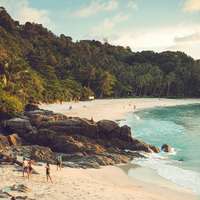
A cultural guide to Phuket
Island hop and gorge on regional dishes at this popular Thai destination
Watch before you go
Bangkok’s reputation as a city where anything goes was only enhanced when it was used as a location in The Hangover Part II. Backpacker hub Khao San Road featured in iconic movie The Beach (although due to crowds, Krabi stood in for many of the scenes).
A haven for foodies, Bangkok’s Chinatown is centered around Yaowarat Road, which is chock-full of food stalls, restaurants and stores. Make sure to stop and marvel at Wat Traimit’s huge Golden Buddha and, as night falls, head to neighboring Soi Nana for the nightlife. It’s touristy but a lot of fun, with venues such as Brown Sugar (jazz) and Wallflowers (head to the rooftop) promising a great night out.
Home to expats and families, leafy Ari in north-central Bangkok is known for its laid-back feel and hipster café scene. Away from the major tourist attractions, it feels a little less manic than other neighborhoods with lots of restaurants and bars. It’s located near the vast Chatuchak Weekend Market, which is always worth visiting in the early morning to avoid the heat. Just don’t forget to haggle.

Alex Gorton is a freelance writer, as well as the former travel editor of Condé Nast Brides. She has visited countries all over the globe, from Chile to Namibia, and lived in France, Canada, and the U.S.
Hotel deals in Bangkok






